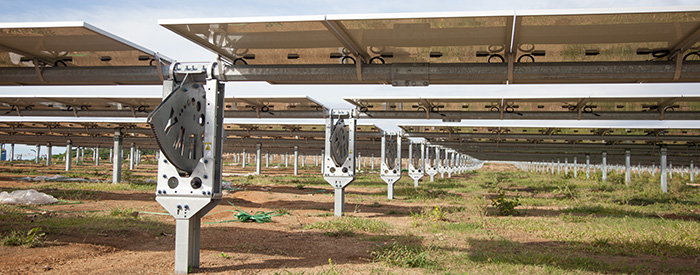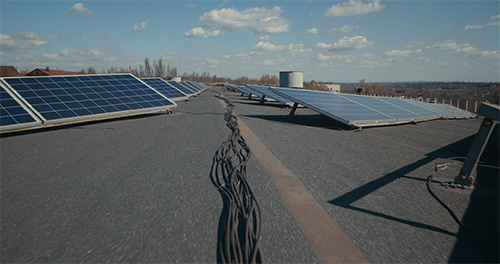Wireless Technology Selection Guide For Solar Tracking!
The rapid growth of the Solar Tracking market has been nothing short of remarkable. According to the Future Business Insights industry reports, the solar tracker market size went from USD 7.88 billion in 2023 to USD 8.78 billion in 2024 and is projected to grow to USD 25.24 billion by 2032. This growth is due to several factors including including advances in tracker control technologies, growing number of solar installations worldwide, cost reductions in solar technologies and equipment, government incentive programs and policies supporting solar and other renewable energy adoption.
This growth has also been trending towards an increase in wireless radio technologies to replace wired tracker solutions in large scale solar field installations. This being said, key considerations need to be made by companies evaluating wireless technologies for new large-scale solar tracker installations. In a market that is growing this quickly and trending towards a wireless installation approach, it is of utmost importance to pick the most optimal wireless technology to ensure project longevity and reliable performance under all operating conditions.

Radiocrafts is a global leader in embedded wireless expertise, particularly in Solar Tracking installations where we have collaborated with top tier players in the market, delivering hundreds of thousands of RF modules globally. Using our experience and understanding of today’s wireless technologies, we have put together a complete guide to help you select the best wireless option for Solar Tracker installations.
In the Solar Tracking selection guide we focus on 8 crucial concepts to help you make the best technology decision including:
- Why wireless and not wired?
- Wireless challenges in Solar Tracking
- RIIM vs ZigBee vs Wi-SUN vs LoRa (Technology Comparison)
- RIIM for Solar Tracking
- Why choose RIIM? (Radiocrafts’ Sub-GHz mesh solution optimised for Solar Tracking installations)
- What do our customers have to say?
- Summary: Why Sub-GHz Mesh?
- Take the next step with RIIM
Section 1: Wired vs Wireless
The guide starts-off with explaining the pros of using wireless solutions versus wired solutions for Solar Tracking installations. We dive deeper into the higher costs and complexities, higher maintenance and damage risks, and the inflexibility of installing a wired solution versus the lower maintenance and installation costs, ease of installation, and the increased scalability and adaptability of a wireless solution.

Section 2: Wireless Challenges in Solar Tracking
In this section we use our vast experience and knowledge in working with top tier companies to share insights on the wireless challenges we see in the Solar Tracking market. We elaborate on the importance of solar tracking and how it can increase the energy output of solar panels by up to 40% compared to static installations.
Furthermore, we emphasize the importance of reliable wireless connectivity, particularly because utility scale solar installations can have up to 10,000 solar panels in a single location making radio interference a particular challenge in wireless solar tracking. In such large installations, performance issues could lead to substantially increased maintenance costs, for example, delays in moving the solar panels to a safe position during high winds or hail storms.
Finally, we describe how a well designed and whole system approach is essential in a large network for optimal network commissioning.

Section 3: RIIM vs ZigBee vs Wi-SUN vs LoRa (Technology Comparison)
Here we share our wireless expertise with you by comparing the features, strengths, and challenges each of the above mentioned technologies possess and how they perform in a Solar Tracking installation.
We compare various features such as the frequency range (MHz versus GHz), data rates, max outdoor and indoor range, network topology, scalability, reliability, among other features. We also share how these differences affect the network performance for Solar Tracking installations.

Section 4 & 5: RIIM For Solar Tracking and Why Choose RIIM?
Next, we dive deep into Radiocrafts long range Sub GHz mesh solution, RIIM, and the various benefits it offers for Solar Tracking installations.
These benefits include:
- Proprietary technology – Allows for easy customization to meet the unique application requirements of each solar tracking application
- Huge coverage – 40 x 40 km squared utility scale solar field with a single gateway
- Network wide solar panel control – Move panels into safe position within 1 second during high winds or hail storms
- Supports up to 1000 solar panels in a single network
- Pre-certified modules for a fast-to-market experience
- Symmetric downlink and uplink communication for efficient data collection and solar panel control (ex: Over-the-air updates)
- High Reliability – 99.99% successful data delivery rates including in difficult environments
- Frequent solar tracker communication while supporting the vast amounts of data required by a solar installation
- Network partitioning and simplified commissioning for quick rollouts and simple scaling
These benefits and how they can optimise your wireless Solar Tracking installation are explained in detail within the guide.

Section 6: What Do Our Customers Have To Say?
In this section we talk about how Radiocrafts’ high quality, high performance, and cost efficient RIIM modules have supported numerous customers to get fast to market in a wide variety of wireless applications including Solar Tracking.

Section 7: Summary – Why Sub-GHz Mesh?
In this section we once again emphasize the importance of selecting the right wireless solution for your Solar Tracking installation to avoid reliability and coverage issues. Using an unsuitable technology can make scaling your installation even harder to manage as demand grows, increasing both maintenance complexity and costs.
RIIM Sub-GHz mesh provides 99.99% data transmission reliability including in difficult environments, long range to cover your entire utility scale solar field or rooftop installation, and the scalability to support up to 1,000 solar trackers reliably with a single gateway. Its future-proof design ensures your system will remain dependable for decades.
Section 8: Take The Next Step With RIIM
In this final section of the guide we give you insights on how you can get started with testing RIIM for your next Solar Tracking project. Th easiest way to get started is to get your hands on a Solar Development Kit which provides you with an easy-to-use evaluation and prototyping solution. In addition, we are happy to hop on the next plane to show you a live demonstration at your installation site!
Download the Wireless Technology Selection Guide For Solar Tracking from our website to learn more about how you can optimize your Solar Tracking projects with Sub-GHz Mesh radio!

